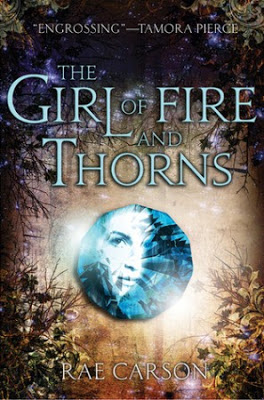 Stories set in various unfamiliar areas – deserts, high mountains, flatland prairies – can be neat things to read, because the weather, animal life, and entire lifestyle is so different. This novel presents a nomadic desert people who remind me a lot of the people with whom the young Alana stayed in Tamora Pierce’s Lioness books. The author stays true to a fish-out-of-water character in that setting, and just on that very basic level creates a book which comes across as very real. That’s what gets you – there are other very “real” aspects which deal with characterization, sibling relationships, etc., which just made the plot sing. Pick this one up, guys.
Stories set in various unfamiliar areas – deserts, high mountains, flatland prairies – can be neat things to read, because the weather, animal life, and entire lifestyle is so different. This novel presents a nomadic desert people who remind me a lot of the people with whom the young Alana stayed in Tamora Pierce’s Lioness books. The author stays true to a fish-out-of-water character in that setting, and just on that very basic level creates a book which comes across as very real. That’s what gets you – there are other very “real” aspects which deal with characterization, sibling relationships, etc., which just made the plot sing. Pick this one up, guys.

Reader Gut Reaction: Elisa is so sure she knows everything in her world, and her place within it. She knows for sure that a.) her sister hates her, b.) she’s not meant to be a queen, and c.) in spite of the gift of the Godstone within her, and the reality that she has a mission on earth, she doubts that she can fulfill it.
The novel starts off quietly – with a wobbly, unsure new bride. Briefly, the plot seems to sway toward being a traditional “learning about her Prince Charming” sort of thing, but then, as the first lies are told, there’s this sense of “WHAT? This is not how a Grand Romance is supposed to go. Good thing, since that’s not quite what the novel turns out to be.
There’s an interesting religious component, with a Godstone and ceremonies and things which somewhat mirror a liturgical service, but with its own twist. There are nasty sorcerers and innocent bystanders and those who should have been Defenders, but who are instead defenseless and bewildered. All in all, this is a twisty, surprising novel which kept me reading for one long afternoon.
 Concerning Character: Elisa begins her story an unsure and wobbly princess; though she’s quite young, she’s being sent to marry to unite kingdoms. It’s kind of her job – she knows this – but she can’t help but think that her sister would be so much better at it. Unfortunately, she thinks her sister believes that as well.
Concerning Character: Elisa begins her story an unsure and wobbly princess; though she’s quite young, she’s being sent to marry to unite kingdoms. It’s kind of her job – she knows this – but she can’t help but think that her sister would be so much better at it. Unfortunately, she thinks her sister believes that as well.
Repeatedly, throughout the first few chapters of the novel, Elisa gives up – and gives in. It’s easier to fill her mouth with temporary sweetness and deliciousness than to deal with what’s in front of her. A husband. A secret. And people who hate her. She’s got to learn who to trust – and she’s making mistakes which she can’t afford to make.
For anyone who has ever struggled with an eating disorder, the description of Elisa just stuffing down her feelings along with her food might make you need to get up and pace a bit. It’s intense and suffocating, and utterly realistic. Overeating helps Elisa cope, but as always, any endorphin high is only temporary, and afterwards, she feels worse than ever.
Elisa has to take hold of her faith in order to take hold of her life. But, no one said it would be easy.
Recommended for Fans Of…: Tamora Pierce, Song of the Lioness and all the Tortall books, also Graceling and other books with strong female characters.
 Cover Chatter: I’m pretty sure that when this book came out, it was already highlighted ad nauseum as having a “whitewashed” cover. The novel clearly describes Elisa as being “dark;” at one point, she revisits a childhood memory in which her sister cites that “dark and ugly” thing as the reason her mother breathes her last and dies — so it’s kind of a fairly salient point in Elisa’s memory. We might as well be looking at her pale, beautiful sister on the cover of the first novel.
Cover Chatter: I’m pretty sure that when this book came out, it was already highlighted ad nauseum as having a “whitewashed” cover. The novel clearly describes Elisa as being “dark;” at one point, she revisits a childhood memory in which her sister cites that “dark and ugly” thing as the reason her mother breathes her last and dies — so it’s kind of a fairly salient point in Elisa’s memory. We might as well be looking at her pale, beautiful sister on the cover of the first novel.
More than the color issue, Elisa is heavy. Not curvy-cute and rounded heavy, but unhealthy, dragging, weary and ill-heavy. While I don’t expect them to necessarily picture that Elisa on the cover, the girl with the flashing eyes and dark hair on the ARC cover certainly bears not even a remnant of that person. Unfortunately, a lot of the novel was spent being that person; even when she wasn’t the same unhappy person, her body didn’t change into a pale size 4 with some magician’s wand. Here was an opportunity to depict even a slightly rounded cover model, and it was missed. Unfortunate.
The replacement cover is more traditional than striking – the U.S. cover features a faceted Godstone with a face in the center, with smoky jewel colors and poisonous flowers – which relate directly to the plot. The UK cover has an exoticized perhaps Arabic, perhaps South Asian looking person wearing Traditional Desert Garb – okay, Elisa probably wore something close to this, and the cover model looks queenly here, but the line of camels makes me laugh. The desert folk wish they had that many camels and that no one had to walk!
Authorial Asides: Rae Carson was once a beauty queen. No lie. How this prepared her for writing a desert culture, I can’t be sure, but it did give her insights into human nature and some great stories she’ll probably never forget.
You can find THE GIRL OF FIRE AND THORNS at an independent bookstore near you!
Wow. I've heard about this book, but not about the whitewashed cover aspect. Sigh. Maybe I'll give this book a try.
Same here. I've heard several good things about it–and I think I saw it at the library when I was there last…